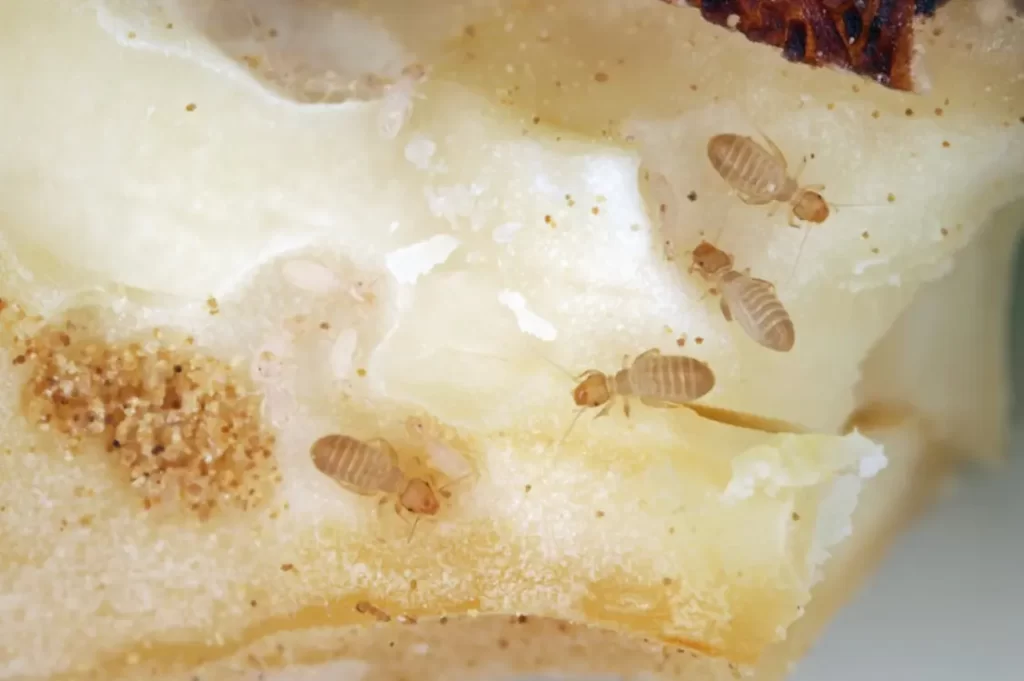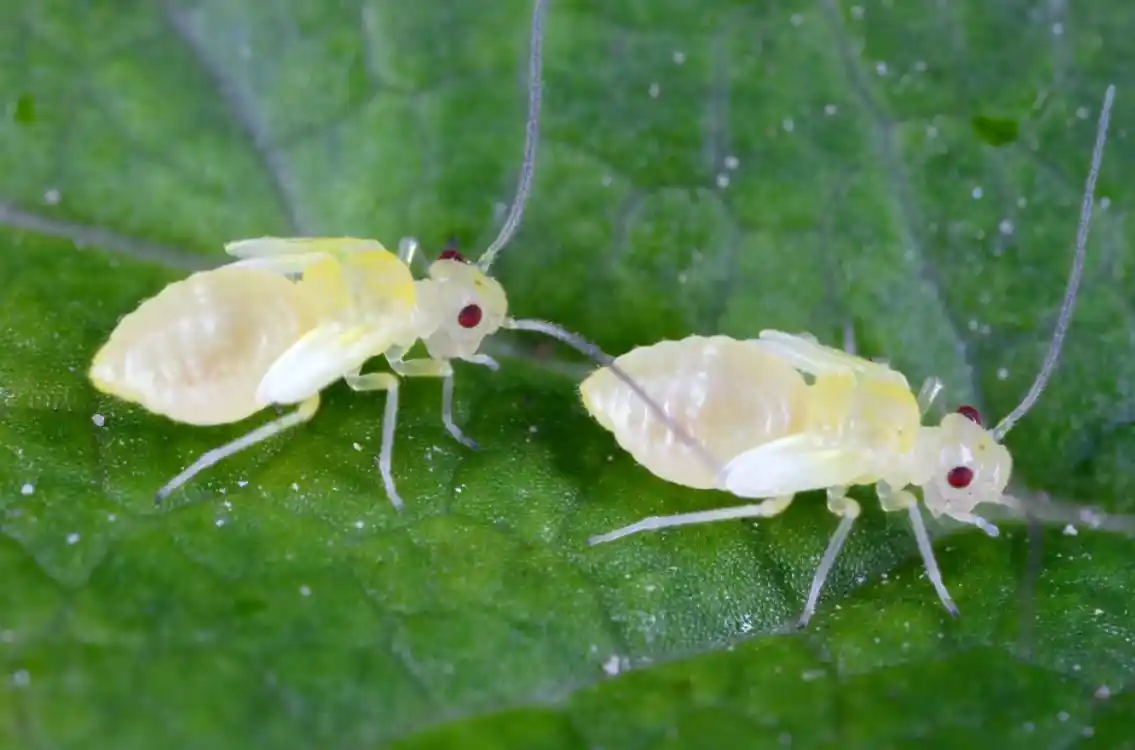Psocids, or booklice, are a type of tiny bug commonly encountered in books and other related documents.
Booklice are a common household pest that doesn’t get attention like ants or mice do. There are likely a few things you don’t know about booklice that we’ll cover in this article.
These little insects hide a fascinating family tree and an ability to go months without eating, proving that there is more to them than meets the eye. Let’s get right into the unexpected realm of booklice.
Page Contents
Fact #1: Booklice are not actually lice
Can you handle a frightening truth about booklice? Surprise! They’re not even lice! We agree that it’s a really deceptive name.
No, but seriously, it’s the truth! Booklice are insects of the genus Psocoptera and the subfamily Psocopteroidea.
Although they share some physical similarities with lice in that they are both very little and can be discovered in books, this is where the comparisons end.
However, that’s not the craziest part. Booklice are more closely linked to ants and bees than to lice; did you know that? That’s right!
Don’t be too hasty to call one of these fellas a pest the next time you encounter one. The world misunderstands them because they are insects.
You might be wondering what booklice are doing in your books if they aren’t actually lice. Well, they like the mold and fungi that can grow on paper and cardboard, so old, damp books are a common place to find them.
Aside from the bathroom and the basement, you can also find them in other wet or humid places.
Thus, you now have the complete picture. Booklice are not actually lice, but rather mold-loving insects that have been given the wrong name.
However, unlike lice, they pose no health risks to humans and won’t give you the creeps. As long as you avoid damp and moldy conditions, your books should be safe against booklice.
Fact #2: Booklice do not carry diseases

Well, here’s another bit of information that might catch you off guard: booklice don’t spread disease. Yes, these microscopic insects pose no health risks to human beings at all.
They don’t even bother to bite because they’re so gentle. To pass the time, they happily consume mold and mushrooms.
You might be thinking, “What’s the big problem if booklice are in my house if they don’t spread disease?”
Well, they might not be dangerous to your health, but they sure are annoying. They feed on paper and other materials, causing harm and rapid reproduction if not eliminated.
But have no fear; eliminating booklice is a simple process. Keep your books away from moisture and store them in a cold, dry place to reduce the risk of an infestation.
Even if you do end up with booklice in your house, there are many efficient pest control options available to help you get rid of them.
Thus, you now know that booklice are not only harmless, but also not the most desirable of pests.
If you keep a close eye on your books and store them in the right way, you shouldn’t have to worry about booklice for very long.
Fact #3: Booklice can survive without food for months
Are you prepared to hear another shocking revelation about booklice? Despite their small size, these insects may go months without eating.
In other words, they’re the last people standing. Booklice can survive for up to four months without food if they have a constant supply of water, according to research.
The question on everyone’s mind is, “How do they survive that long without food?” I’ll tell you how.
Their small stature and slow metabolism are to thank for this. Booklice can go into a dormant state called torpor, where their metabolism slows down and they need less energy. They can go for a very long time without eating this way.
Even though booklice can go without food for months at a time, that doesn’t imply they’ll go hungry if you don’t leave any moldy books laying around.
They’ll happily chow down on mushrooms and algae if given the chance. Some booklice species have even been observed sucking nectar and pollen from flowers.
There you have it; despite their size, booklice are formidable survivors. If you keep a close eye on your books and store them appropriately, you shouldn’t have to worry about booklice invading your home.
Fact #4: Booklice are found in a variety of environments.
We have another shocking truth about booklice to share with you. You may find these tiny insects almost anywhere.
Indeed, booklice can be discovered anywhere from your own living room to the depths of a forest or a cave.
Booklice can be found on every continent except Antarctica, and scientists have identified more than 3,000 different species.
You might be wondering how booklice can live in such a wide variety of conditions, and I get it. Because of their flexibility, that’s why. As long as they have a source of moisture and food, booklice can survive almost anywhere.
Though booklice are ubiquitous, that doesn’t mean you can’t protect your books from them. A few simple precautions can help keep booklice out of your home.
As you can see, booklice are remarkably flexible despite their little size. You may reduce the number of annoying insects in your home or workplace by taking certain preventative measures.
Fact #5: Booklice can damage books and other materials
Do you want to hear an “expected” fact about booklice? Those little bugs may do some serious damage to paper and other things!
Yes, booklice eat the glue and bindings, leaving books vulnerable to damage or even destruction. Booklice may be responsible for the annual destruction of millions of books, according to some estimates.
I know what you’re thinking: how can such tiny insects wreak so much damage? Their sheer numbers, that’s why. A huge population of booklice can swiftly cause extensive damage to books and other materials if not eradicated.
Worry not, though; there are measures you may do to keep booklice away from your collection. The importance of correct storage cannot be overstated.
Booklice can be avoided by keeping books in a dry, cool environment and storing them in dust-free covers or crates.
By keeping a close eye on your books, you can spot any booklice problems early and treat them effectively.
So, although booklice are so diminutive, they can cause significant harm to books. If you take the necessary steps for storing and preventing damage to your books, you can keep these small pests at bay.
Fact #6: can booklice fly?
Are you wondering if booklice can fly? Well, here’s another shocking fact about these minuscule insects: Booklice can’t fly! True enough, booklice can’t even take off from the ground. Booklice don’t fly because most species lack wings.
You might be wondering, “How do these tiny guys get around?” Actually, booklice can get around thanks to their crawling and jumping abilities.
Because of their diminutive stature and light frames, they may also glide for brief distances.
Even while booklice can’t fly, that doesn’t make them any less of a nuisance. It is still possible for them to cause harm to books and other materials by feeding on the glue and bindings, and they can swiftly reproduce if not eliminated.
That settles it: booklice are a problem whether or not they can fly. You can help keep these little insects out of your home or place of business by taking the necessary preventative and control steps.
Tips for preventing booklice from entering your home or office
Have you had it with booklice at your house or office? The good news is that there are many steps you can take to prevent these pests from ever appearing.
The first and most important step is to find a suitable place to keep everything. It’s important to store your books and other reading materials in a dry, cool environment.
Mold and fungi, which booklice love to eat, will be kept at bay. It’s also a good idea to store your books in sturdy containers or covers to avoid booklice.
Keep your home or workplace tidy and well-ventilated in addition to storing things properly. As moisture is essential for booklice’s survival, this may assist avoid its accumulation.
You can catch booklice early if you inspect your books and other materials often for signs of deterioration.
Also, there are several easy measures you may take to prevent importing booklice into your house or workplace from the outside.
Please don’t bring in any worn books or other materials from strangers, and always check new purchases for booklice.
By keeping these precautions in mind, you can lessen the chances of booklice damaging your collection.
Conclusion
Despite their diminutive size, booklice are interesting creatures. These tiny pests are more complex than first meets the eye, from their baffling family tree to their remarkable ability to go months without eating.
Booklice are a common pest that can cause damage to books and other paper items, but they are not dangerous to humans and can be easily avoided.
Help avoid booklice infestations in your home or office by keeping books dry, storing them in a cool, dry place, and examining them often for indications of damage. Don’t be so hasty to squash that booklouse the next time you see one.
Think about how these small insects have managed to survive and thrive in such a wide variety of environments; then take necessary precautions to keep them out of your home or workplace
- Where Can I Purchase Bed Bug Bombs? - January 30, 2023
- Where Can I Buy Something to Kill Bed Bugs? - January 30, 2023
- Where Can I Buy Bed Bug Spray? - January 30, 2023
